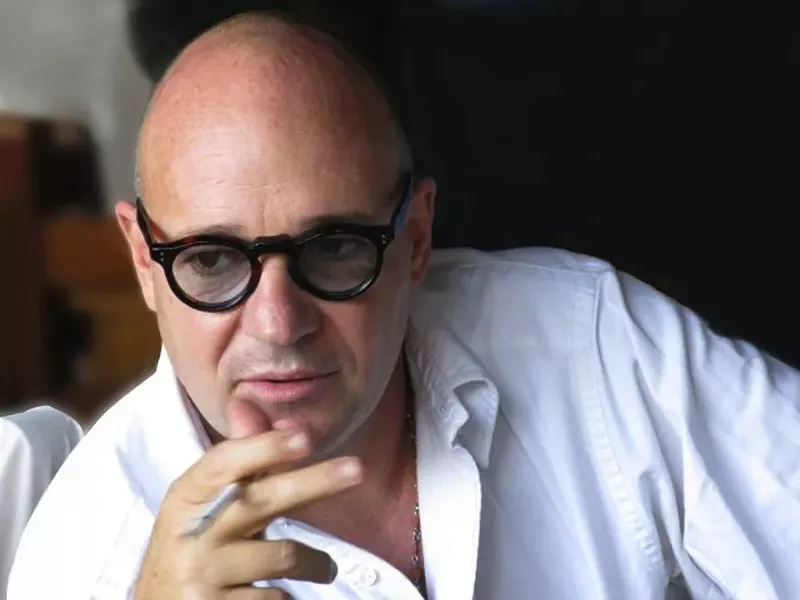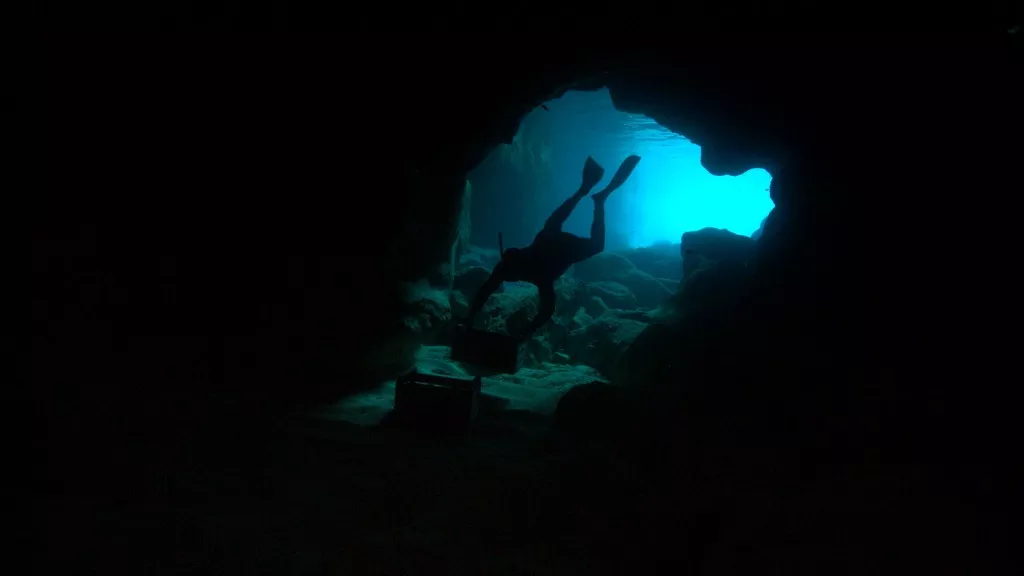The entire time Gianfranco Rosi is talking, he’s drawing. Using a graphite pencil against an unlined notebook, the Italian documentary filmmaker instinctively makes quick sketches to illustrate his ideas and anecdotes. Counting off the number of windows on a ship, he draws three little squares. Talking about the deathly Mediterranean journey of migrants from Libya to the Italian island of Lampedusa, where he shot his new film Fire at Sea, he maps the path on the page and quickly fills it with lines and circles reflecting the complexity and tragedy of what he observed. With his architect’s glasses, ever-present scarves and conversational ability to go from zero to offhanded poeticism in seconds flat, Rosi comes across as an artist with expressiveness to spare.
This latest film is bringing him the greatest acclaim — it took home the Golden Bear at the Berlin Film Festival and has been put forward as both Italy’s foreign-language film submission and a candidate for Best Documentary at the Oscars — but it’s in keeping with a larger body of work. Often shot over several years, Rosi's films are born of intensely intimate relationships with his subjects, sophisticated narratives filled with ambitious metaphors, brazen lyricism and complex tonalities. Over lunch at the Toronto Film Festival this past September, Rosi talked (and sketched) about his distinctive artistic process.
You spent a year and a half with the people of Lampedusa for Fire at Sea, and with Below Sea Level you were in Slab City, California for twice that long. Do you wait for something specific to happen? Is there a particular story you’re hoping will unfold?
Documentary challenges you constantly to find a new way of telling a story. That’s what I love about it: to start a journey without knowing where I’m going to arrive. At first I have to encounter a place. Then within the place I have to encounter people. Then I have to make a void — like there doesn’t exist anything else but the people I want to carry with me in my film. I have to fall in love with all of them. I start following their lives and seeing moments. I want to show the essence of what I find engaging about them. I identify with certain parts of them, and so they each become a sort of archetype. And then instead of opening up to the world, I start closing it up. I’m taking things off. I have to subtract to create the essence of something.
It sounds very sculptural.
It is. My ideal is always Giacometti. When I think about subtraction, I think of making it as thin as possible while still holding up. And what I’m subtracting is information. We live in a world where we have so much information about everything. To make a documentary that gives information — I’m not interested. I want to make something that somehow transforms the reality into something else. It becomes like a suspension of elements, where the audience has to start to interact with their own knowledge of things. Or maybe with their own emotional understanding of things, and then create their own world. I love when 50 people see 50 different things in my film emotionally.
You talked about your subjects becoming archetypes. How do you honor their lives while constructing something — this film of yours — out of those lives?
I don’t care if I’m making a fiction film or documentary — to me it’s a film, it’s a narrative thing. My duty, though, when it’s a documentary is to be truthful to the person I have there. For me it takes a long time in relationships in order to understand how to feel. I cannot know the person in a few hours. I have to spend months and months and know the whole situation before I pull my camera out. From there it becomes an interactive transformation. Because when you have a camera things change, no matter what.
Yet for Fire at Sea, in contrast to the relationships you forged with the islanders, you were also filming people that you didn’t know intimately — refugees who were literally passing through on their way to the mainland. How did you aim to reflect that, while also bringing us as close as you could get?
I didn’t want to stick my camera in front of people and ask them how it was for them to be here. I would have gotten all these embarrassing answers. You have to be able to grab a moment of truth of life so intimate that it won’t come from asking questions. It’s always witnessing a moment. And then you disappear. These two worlds barely touch — the migrants and the islanders.
The migrants are brought in from the coast guard in these little boats. They arrive at night, are brought into the main camp, identified, searched, given new clothes and after two days they have to go to the mainland in Italy to wait to obtain a permit of a political refugee. There’s no interaction. Zero. So I wanted to use this as a metaphor for Europe. They’re aliens to each other. Two worlds that get very close to each other but don’t touch.
Your film enfolds these two worlds throughout. Does structure come afterwards or during the shoot itself?
If you don’t have a structure in every frame you make, there’s no way you’re going to have any [overarching] structure. So it’s very important that somehow every sequence for me has a beginning, middle and end while I’m filming. Now, I’m a one-man crew — I’m very focused on what’s happening. I find the distance with the camera, the right point of view, because if you tell the story here or here or here, it’s completely different. And you adapt yourself to the story that’s going to unfold in front of you. And you say, “Okay, this is a good beginning for a story. Let’s see where it goes.” It could be a sentence. It could be a moment. It could be silence. But it also has to have an end.
Meaning an end to the sequence?
Yes, sequences, it always has to be sequences. I cannot think, “Oh, this was good and that was good, and let’s start editing.” There are sequences with a beginning, middle and end. And another one with a beginning, middle and end. Like poetry.
The line ends, and then you begin another line.
Or like musical notes. Knowing this note has to go with that note, otherwise it will be cacophony. This note works with this because it continues from that note. It’s storytelling. Then once I have all this in my mind, I have to start editing. And I never look at the footage during the shoot — I can go two or three years without watching the footage, and for Below Sea Level it was four years. But if I were to ask you what happened this year in your life, you’d close your eyes and come up with maybe 10, 15, 20 episodes. You don’t know every single day — the rest is gone. So when I edit I do the same. I remember that moment and that moment and that moment, and I find them all and they become a three- or four-hour structure based on my memory.
You don’t look through all of the footage?
Never. Because if you go back to watch everything, you have problems. You won’t know where to go.
The footage starts telling you what to do, or what you could do, instead of knowing what you want it to do.
It goes terribly wrong. What came out is because I was following a structure [while filming]. All this is a story that I shot. I start working only on what my memory is holding onto. That’s why when we edit it’s just one to two months.
How many hours were spent shooting?
Maybe 70 hours. I only shoot when I’m ready to shoot. I hate the act of filmmaking. I have to put the camera down. I also always wait for the light, the clouds. I wonder why do I always have to wait for the clouds? I think it’s a way of postponing my shooting. Oh, it’s a clear day, I can’t shoot — I’ll sleep. Limit it even further. Postpone the pain of shooting. Most of the good things happen before I film. Then when I film something else happens.
And you’re okay with that?
I don’t have the anxiety that I have to grab everything. Then when I’m ready to film, the essence has to come from here [motions inside his chest]. That moment becomes this incredible sharing with the person in front of me. You know that it’s the right moment. You have to know when to arrive in the moment and when to leave.
That’s quite a time commitment, and sounds like an emotional one as well.
I can do it because I’m a one-man crew. It would be impossible otherwise. Also I have no family anymore. Before that I had two films and two divorces. Whenever I make a film I have to divorce.

Audio By Carbonatix
[
{
"name": "GPT - Billboard - Slot Inline - Content - Labeled - No Desktop",
"component": "16971022",
"insertPoint": "2",
"requiredCountToDisplay": "2"
},{
"name": "STN Player - Float - Mobile Only ",
"component": "18617832",
"insertPoint": "2",
"requiredCountToDisplay": "2"
},{
"name": "Editor Picks",
"component": "15769925",
"insertPoint": "4",
"requiredCountToDisplay": "1"
},{
"name": "Inline Links",
"component": "16575154",
"insertPoint": "8th",
"startingPoint": 8,
"requiredCountToDisplay": "7",
"maxInsertions": 25
},{
"name": "GPT - Rectangle 2x - Slot Auto-select - Labeled",
"component": "15782206",
"insertPoint": "8th",
"startingPoint": 8,
"requiredCountToDisplay": "7",
"maxInsertions": 25
},{
"name": "Inline Links",
"component": "16575154",
"insertPoint": "8th",
"startingPoint": 12,
"requiredCountToDisplay": "11",
"maxInsertions": 25
},{
"name": "GPT - Leaderboard to Tower - Slot Auto-select - Labeled",
"component": "15782207",
"insertPoint": "8th",
"startingPoint": 12,
"requiredCountToDisplay": "11",
"maxInsertions": 25
}
]





